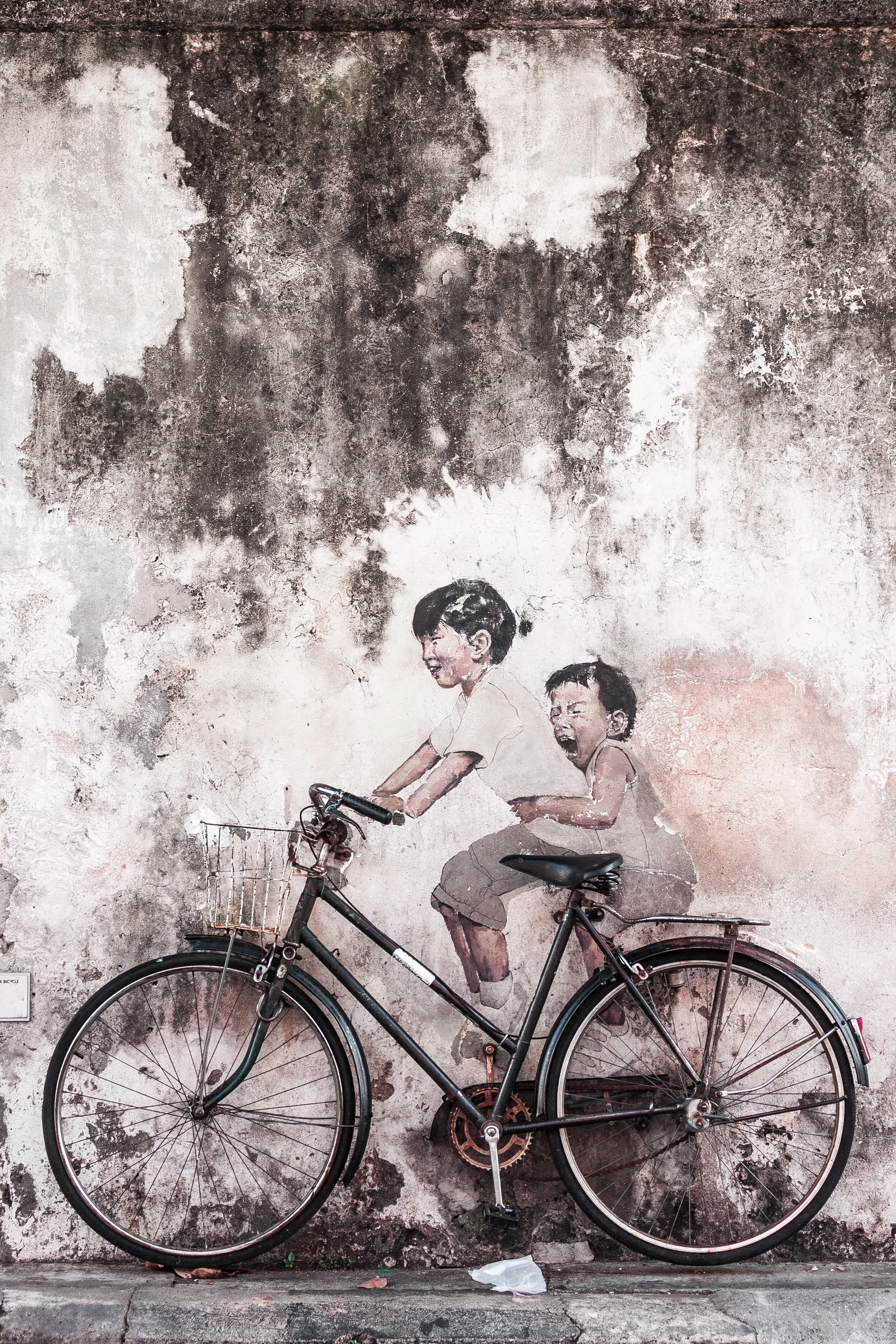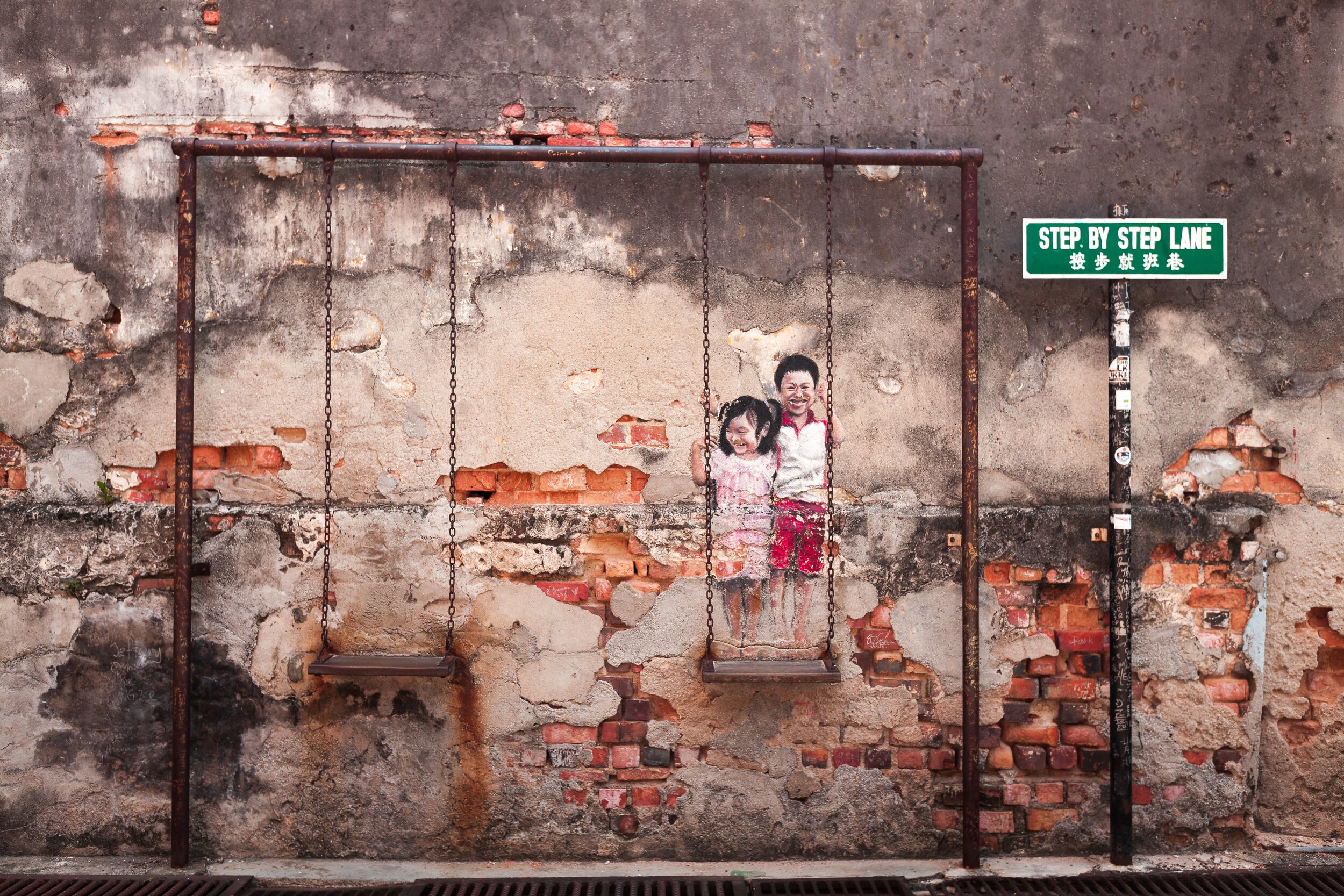Ernest Zacharevic is a Lithuanian-born artist who made his mark creating iconic street murals on the island of Penang in Malaysia. Despite good intentions, Zacharevic’s work prompted the rise of tourist attractions that lack the soul and authenticity that made Penang a UNESCO World Heritage Site in the first place.
The iconic “Little Children on a Bicycle” mural in Penang. Yaopey Yong. Unsplash.
Penang’s historical capital, George Town, was officially inscribed as a UNESCO World Heritage Site in 2008. Since the 18th century, this Malaysian city has been a prolific hub of cultural and commercial exchange. Today, it remains a multicultural hot spot. George Town is also home to a unique layout of mixed architecture that also reflects the region’s history. From its colonial-style British office buildings to its rustic Chinese shophouses, George Town’s mismatched grid of alleyways and side streets bolsters the place’s almost stuck in time sentiment. To further enhance George Town and its diverse history, the George Town Festival was launched in 2010 as a platform for dance, theater and other regional artistic endeavors.
In the midst of this budding art movement, Lithuanian-born artist Ernest Zacharevic began to make his literal mark on the walls of George Town. As an experimentalist known by some as “Malaysia’s Banksy,” Zacharevic’s style revolves around ever-changing concepts, manifesting in his preference for outdoor art. Zacharevic’s primary interest lies in the relationship between art and the urban landscape. Consequently, he mainly flits between stencil, spray and other types of tools conducive to dynamic and public pieces.
One of the more famous interactive pieces. Yaopey Yong. Unsplash.
Although local pieces funded by Sculpture At Work also grace the walls of George Town, Zacharevic’s pieces are the main attraction thanks to the George Town Festival 2012 project “Mirrors George Town.” His iconic and sometimes interactive pieces like “Little Children on a Bicycle” and “Brother and Sister on a Swing” became hot-ticket items for both visitors and locals alike to experience. The open-air exhibitions became so popular that various travel blogs offered the best walking maps for viewing the murals.
“The Little Boy with Pet Dinosaur” and “Boy on a Bike” murals side by side. Travelationship. CC BY-NC-ND 2.0.
In 2013, Chairman of Penang Global Tourism Ooi Geok Ling felt that Ernest Zacharevic “captured the essence of Penang. I know he spent a lot of time here, soaking it all in when he was visiting. He could translate that into his murals.” Ling also believed that Zacharevic’s influence would also help to expand the reach of local artists and small galleries in the city. Indeed, most of Zacharevic’s pieces are reflective of the city and country’s diverse populace. Murals portray children cycling through the city, a painter attending to a pair of clogs, and even more modern scenes of phone booths and curious cats.
Since the creation of these murals, Penang has experienced an influx of “Instagram tourists” and the subsequent boom of businesses that cater to them. The town’s soul, as the South China Morning Post wrote, has been “warped.” Before the worldwide lockdown, older buildings in George Town had begun renovating in a way that catered to foreign tastes. Cookie-cutter coffee shops, museums and art galleries began lining the centuries-old landscape, sapping away at the gritty authenticity of the once safely obscure town.
In response to this commercialization, Ernest Zacharevic made a statement on his Instagram in July 2019. He lamented, “Myself and many others blame my work for Armenian Street being a center of [the] tourist route in Penang.” He called the construction of Instagram-friendly places a “circus” and a threat to George Town’s status as a UNESCO World Heritage Site.
Since the worldwide lockdown, however, locals have made it back into the spotlight. Though the Penang economy today is largely devoid of tourist dollars, the city is also free of the overtourism and traffic jams that congested its streets. Nikkei Asia reports that locals now have the chance to reclaim spaces that gentrification took away. Hawker stalls and other peddlers are also refocusing on the needs of residents and the smaller but more consistent business they provide. Local shopkeepers feel that the lockdown has provided the city an unexpected but much-needed reset button. In the wake of this worldwide pause, locals are starting to explore more sustainable possibilities—ones that don’t compromise the historical integrity of George Town or the well-being of its residents.
Rhiannon Koh
Rhiannon earned her B.A. in Urban Studies & Planning from UC San Diego. Her honors thesis was a speculative fiction piece exploring the aspects of surveillance technology, climate change, and the future of urbanized humanity. She is committed to expanding the stories we tell.




